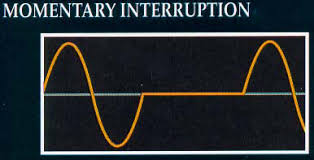Utility Equipment
Momentary Outages and Brownouts

What is happening and how does this affect your electronics?
We have all experienced the short 1-2 second “power blips” that causes our lights to go on/off, our microwaves to reset, computers to turn off, etc. Those of us without an electrical background are left wondering, what is this, is this serious, is there an issue with my house, is this causing damages to my electronics in my house, this can’t be good for my equipment. Many use the terms “brown outs” or “momentary outages”. In this article I want to go over what these events are, what causes them, how they affect your equipment and how to safe guard your facility to prevent damages from these types of events.
Before we get started in this article it is important to know that the electric utility has equipment on it’s system that operate everyday, these operations cause distortion seen in the power entering your home/facility. To be more technical it causes sinusoidal distortion on the voltage waveform and each type of operation has a specific “fingerprint” on the sine wave that is unique to each type of equipment and type of operation. It is also important to know that in every electric utility tariff it will be stated that they can not provide perfect power 24/7, it is up to the end user to protect itself against events beyond the utilities control. However, it is up to the electric utility to keep these events to a tolerable frequency, I will go over what a tolerable frequency is later in this article.
Electric utility equipment
Today we will be talking about electric utility equipment that causes these “brown outs” and/or dimming lights. The equipment that causes these events are know as substation breakers and distribution reclosers. These pieces of equipment respond to faults/outages seen on the distribution mainline. They will cause zero voltage scenarios for very brief periods in attempts to clear the fault. Typically the breaker and/or recloser will operate 3 times before allowing the fault to be seen for a longer duration and thus causing the fuse closest to the fault/outage location to blow. It is important to know that outages have an associated fault current, this current is typically very high. As I stated in one of my previous articles, current and voltage work hand in hand. One goes up the other goes down. So when an outage occurs, even though it might not be near you, current will go up (fault current) voltage will go down, thus is seen as dimming lights in your house. If you are downstream or behind the breaker or recloser responding to the outage you will in turn see zero voltage scenarios vs the voltage sag scenario.
Tolerances
In regards to a tolerable frequency of these types of operations. IEC 61000-4-15 and IEEE 1453 state that 1% deviation from nominal voltage every 2 minutes is within guidelines, deviation of 1-5% of nominal voltage every hour is within guidelines and deviation of 6% or greater once a week is within guidelines. In summary what this means is the normal “brown outs” or “momentary outages” would fall into the weekly “greater than 6% category. The voltage sag to be significant to notice will typically be minimum of 5%.
Public service commission
If you are seeing events more frequent than the above stated timelines I recommend getting ahold of your electric utility and requesting a patrol of the line. This essentially means a troubleman or lineman will assess the mainline to see if there are any shortcomings in the area, or any way they can improve the system to reduce the frequency of these events. Another option is contacting your local PSC (Public Service Commission) and filing a formal complaint. I would like to point out that this should not be your first route. I recommend giving your electric utility the opportunity to resolve the issue first before filing a formal complaint. PSC complaints should not be taken lightly.
Lets say you are seeing 2-3 of these brown outs a month. Just at the frequency before becoming concern, yet you’ve noticed a lot of your electronics seem to not be lasting as long as they should. This is a very very common scenario. SPDs (Surge Protection Devices) are very important to have on every home and every facility. Any SPD is better than no SPD but having the correct one with the proper clamping voltage, properly installed with minimal lead length and proper grounding is important. Each of these utility events causes distortion, faults and transients that can enter your facility/home and slowly cause damages to your electronics if not properly protected.
This is where Alpha Power Systems can assess your facility and determine proper SPD placement, sizing, correct any grounding scheme issues, insure proper lead length to ensure transients get diverted to ground and protect your equipment properly.
For more information contact APS at 813-805-9506.
Check out our strategic partner company ADVANCED POWER QUALITY
